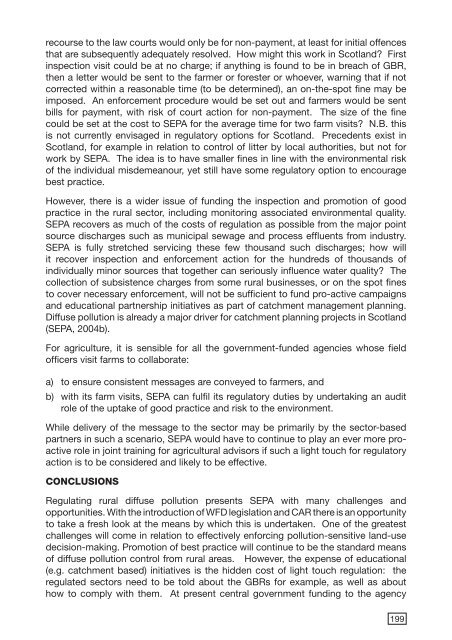Download as a PDF - CiteSeerX
Download as a PDF - CiteSeerX
Download as a PDF - CiteSeerX
Create successful ePaper yourself
Turn your PDF publications into a flip-book with our unique Google optimized e-Paper software.
ecourse to the law courts would only be for non-payment, at le<strong>as</strong>t for initial offences<br />
that are subsequently adequately resolved. How might this work in Scotland? First<br />
inspection visit could be at no charge; if anything is found to be in breach of GBR,<br />
then a letter would be sent to the farmer or forester or whoever, warning that if not<br />
corrected within a re<strong>as</strong>onable time (to be determined), an on-the-spot fine may be<br />
imposed. An enforcement procedure would be set out and farmers would be sent<br />
bills for payment, with risk of court action for non-payment. The size of the fine<br />
could be set at the cost to SEPA for the average time for two farm visits? N.B. this<br />
is not currently envisaged in regulatory options for Scotland. Precedents exist in<br />
Scotland, for example in relation to control of litter by local authorities, but not for<br />
work by SEPA. The idea is to have smaller fines in line with the environmental risk<br />
of the individual misdemeanour, yet still have some regulatory option to encourage<br />
best practice.<br />
However, there is a wider issue of funding the inspection and promotion of good<br />
practice in the rural sector, including monitoring <strong>as</strong>sociated environmental quality.<br />
SEPA recovers <strong>as</strong> much of the costs of regulation <strong>as</strong> possible from the major point<br />
source discharges such <strong>as</strong> municipal sewage and process effluents from industry.<br />
SEPA is fully stretched servicing these few thousand such discharges; how will<br />
it recover inspection and enforcement action for the hundreds of thousands of<br />
individually minor sources that together can seriously influence water quality? The<br />
collection of subsistence charges from some rural businesses, or on the spot fines<br />
to cover necessary enforcement, will not be sufficient to fund pro-active campaigns<br />
and educational partnership initiatives <strong>as</strong> part of catchment management planning.<br />
Diffuse pollution is already a major driver for catchment planning projects in Scotland<br />
(SEPA, 2004b).<br />
For agriculture, it is sensible for all the government-funded agencies whose field<br />
officers visit farms to collaborate:<br />
a) to ensure consistent messages are conveyed to farmers, and<br />
b) with its farm visits, SEPA can fulfil its regulatory duties by undertaking an audit<br />
role of the uptake of good practice and risk to the environment.<br />
While delivery of the message to the sector may be primarily by the sector-b<strong>as</strong>ed<br />
partners in such a scenario, SEPA would have to continue to play an ever more proactive<br />
role in joint training for agricultural advisors if such a light touch for regulatory<br />
action is to be considered and likely to be effective.<br />
CONCLUSIONS<br />
Regulating rural diffuse pollution presents SEPA with many challenges and<br />
opportunities. With the introduction of WFD legislation and CAR there is an opportunity<br />
to take a fresh look at the means by which this is undertaken. One of the greatest<br />
challenges will come in relation to effectively enforcing pollution-sensitive land-use<br />
decision-making. Promotion of best practice will continue to be the standard means<br />
of diffuse pollution control from rural are<strong>as</strong>. However, the expense of educational<br />
(e.g. catchment b<strong>as</strong>ed) initiatives is the hidden cost of light touch regulation: the<br />
regulated sectors need to be told about the GBRs for example, <strong>as</strong> well <strong>as</strong> about<br />
how to comply with them. At present central government funding to the agency<br />
199

















